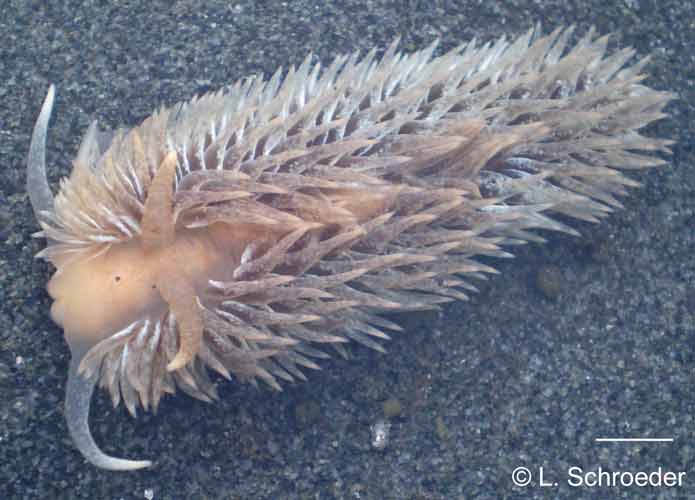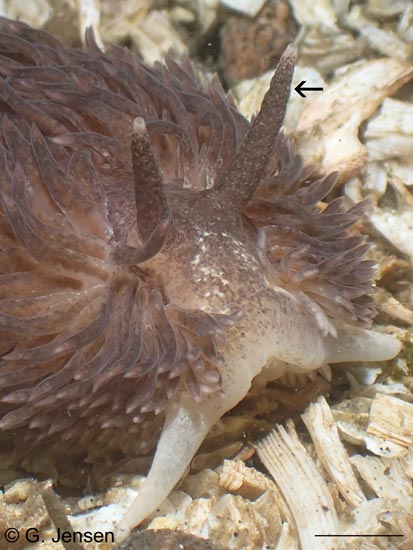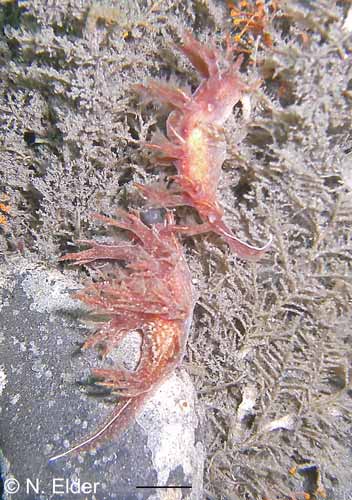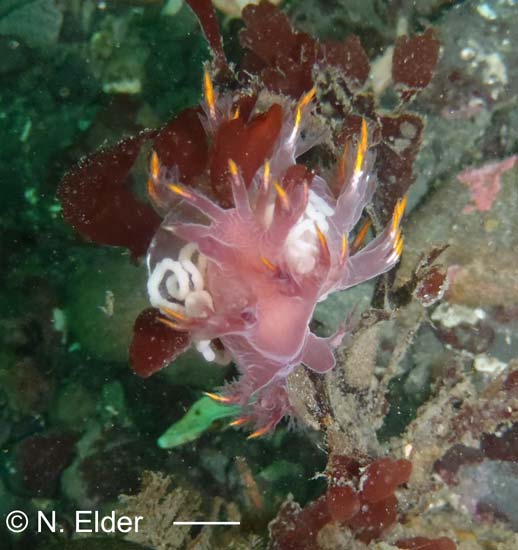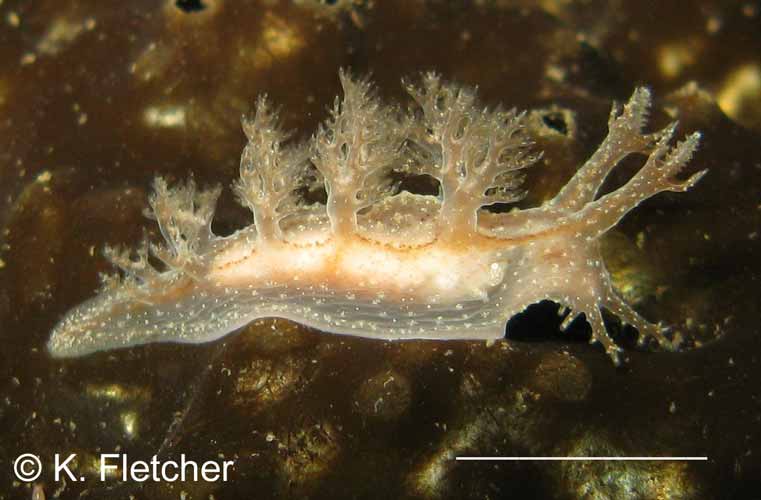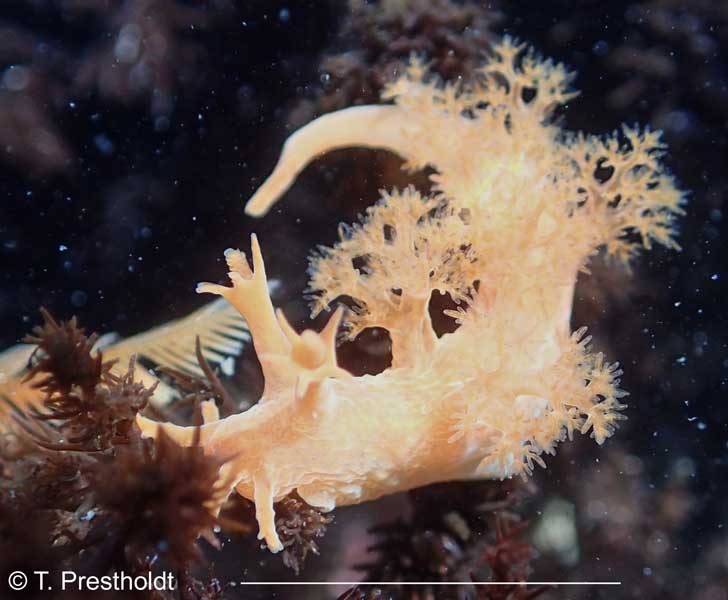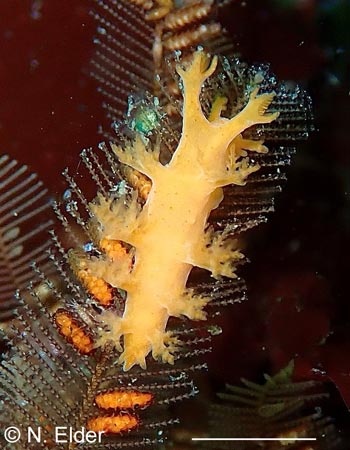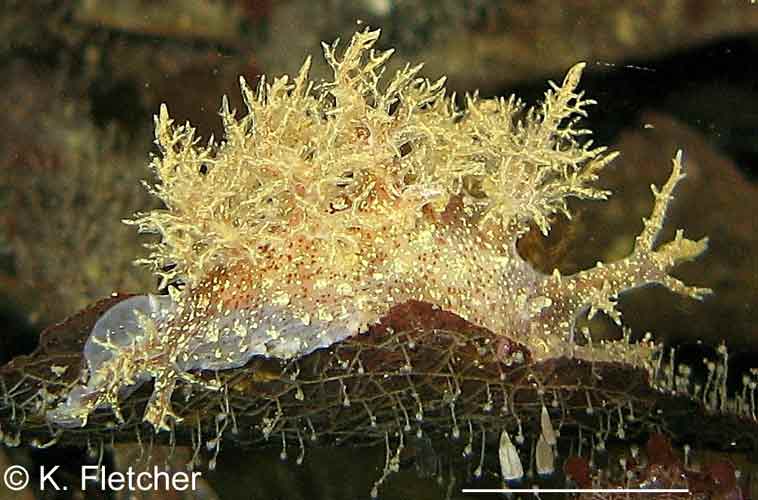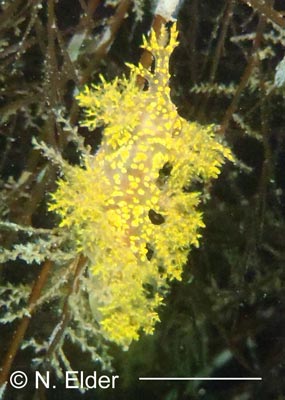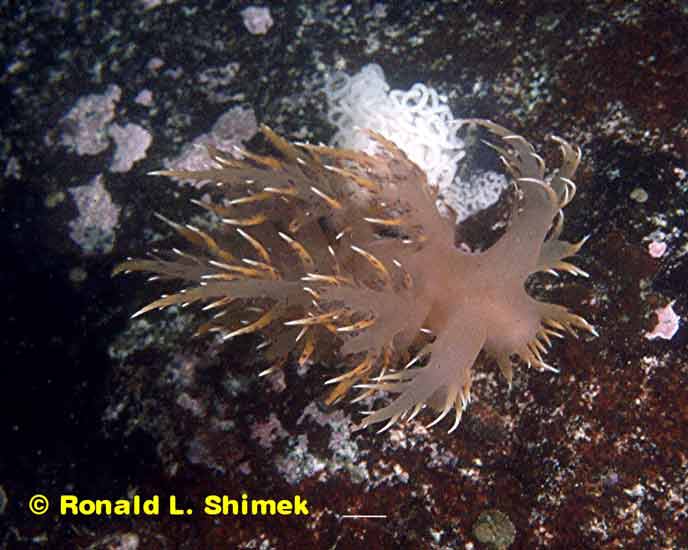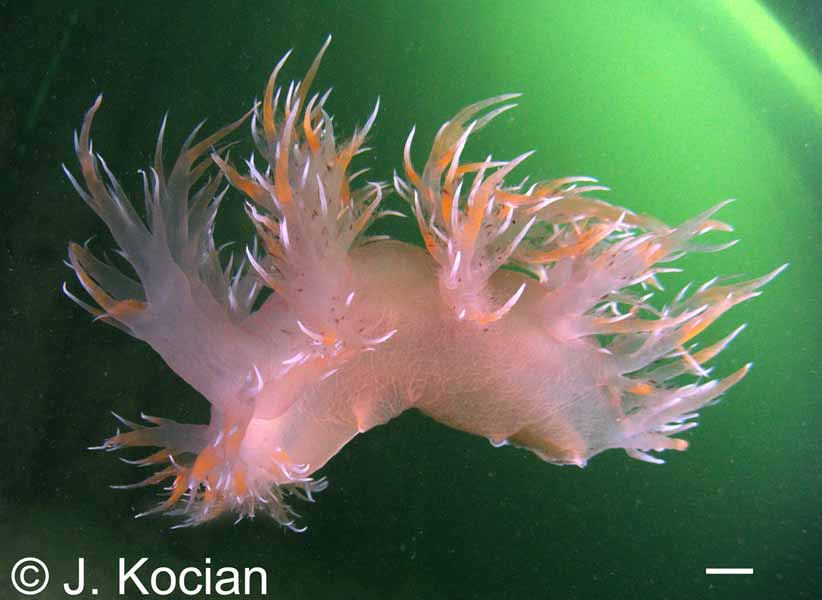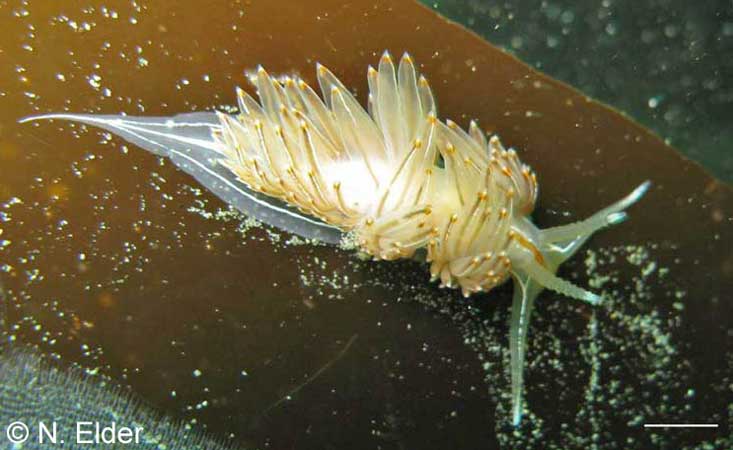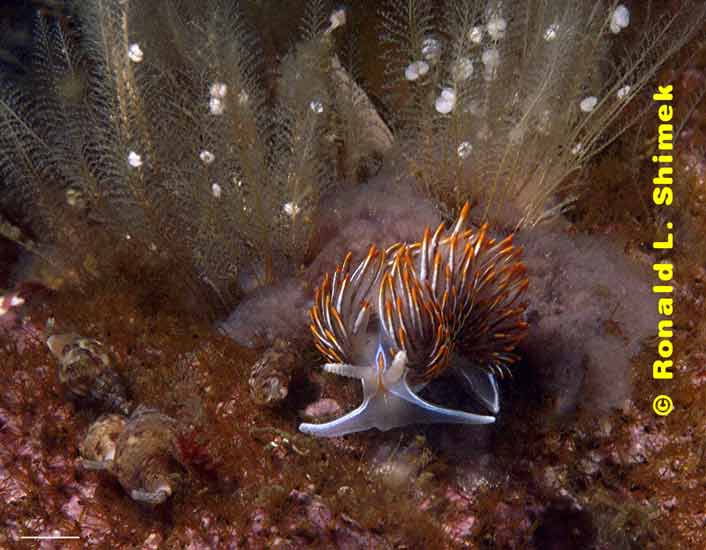Superfamily Dendronotoidea
Superfamily Arminoidea
Nudibranchs and other Sea Slugs
Order Nudibranchia - Suborder Cladobranchia
Superfamilies Aeolidioidea, Arminoidea & Dendronotoidea
Click on photo to enlarge. Scale line in photo equals 1cm unless otherwise specified.
* Species which are the most commonly encountered nudibranchs on the beach.
Those
in the order Nudibranchia are the true nudibranchs. The adult forms
have a complete
absence of a shell and have externally exposed
respiratory
organs.
Superfamily Aeolidioidea
Aeolidiidae
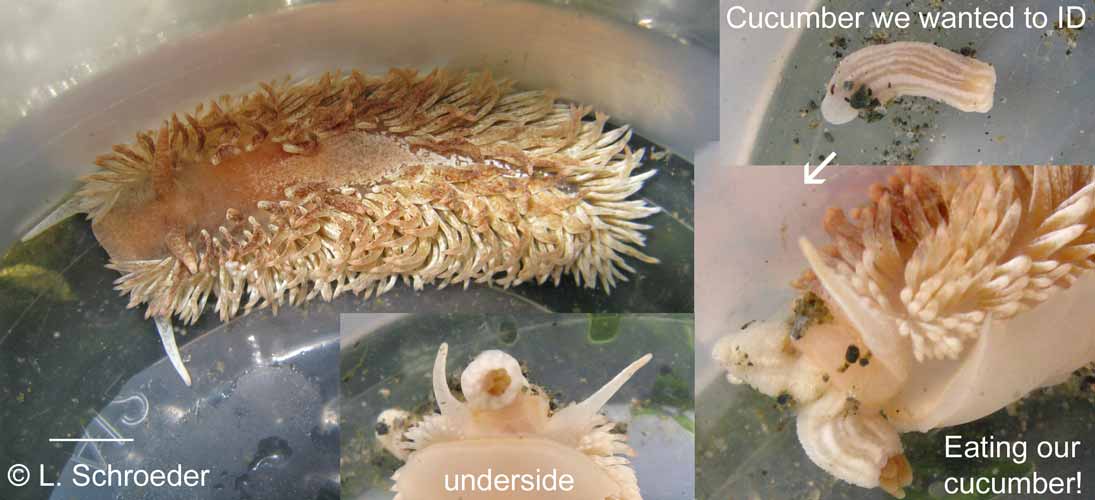

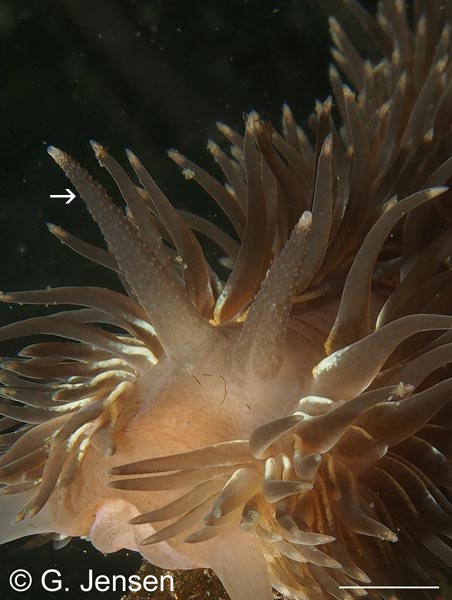
Port Hardy, BC, intertidal
Rich Passage, WA,
subtidal Seattle, WA, subtidal
close-up of warty rhinophores
Aeolidia loui Kienberger, Carmona, Pola, Padula, Gosliner & Cervera, 2016Shaggy Mouse or Shag-Rug Nudibranch
intertidal
to subtidal north Mexico to central
BC size to 100mm
This species was recently separated from A. papillosa.
It overlaps in range and habitat. The body color is variable from
white to pinkish-grayish-green to orange or brown. It's general
appearance is very similar to A. papillosa. However, it's
rhinophores are covered with distinct, wart-like tubercles (see arrow on right photo).
Birch Bay State Park, WA, intertidal
Rich Passage, WA, subtidal
Illahee State Park, WA, subtidal
wrinkled/speckled rhinophores
Aeolidia papillosa (Linnaeus, 1761)
Shaggy Mouse or Shag-Rug Nudibranch *
intertidal to 900m southern California to at least north Vancouver Island, BC size to 127mm
This species is occasionally seen intertidally. The
body and cerata color may be variable - white to beige to dark brown
with dark flecks. The cerata are somewhat
flattened and broader at the base than the tip. The rhinophores
often have a mottled appearance and may have slight wrinkles giving the
illusion of warts. Close inspection is needed while the specimen
is submerged so all the appendages are extended.
Tethydidae 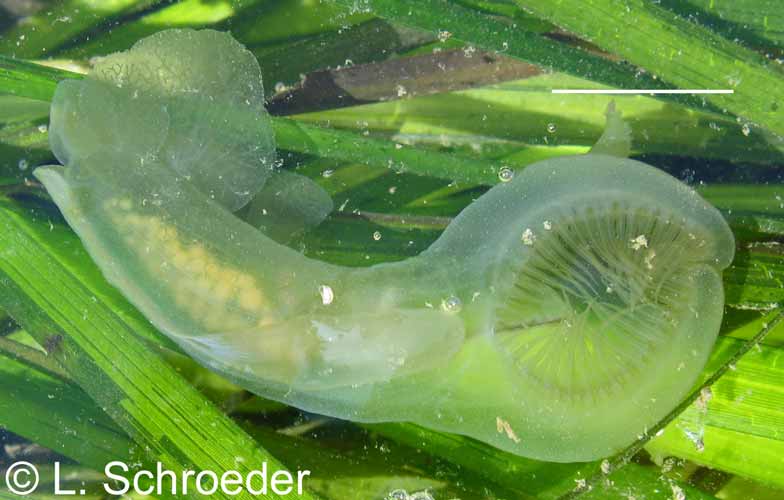
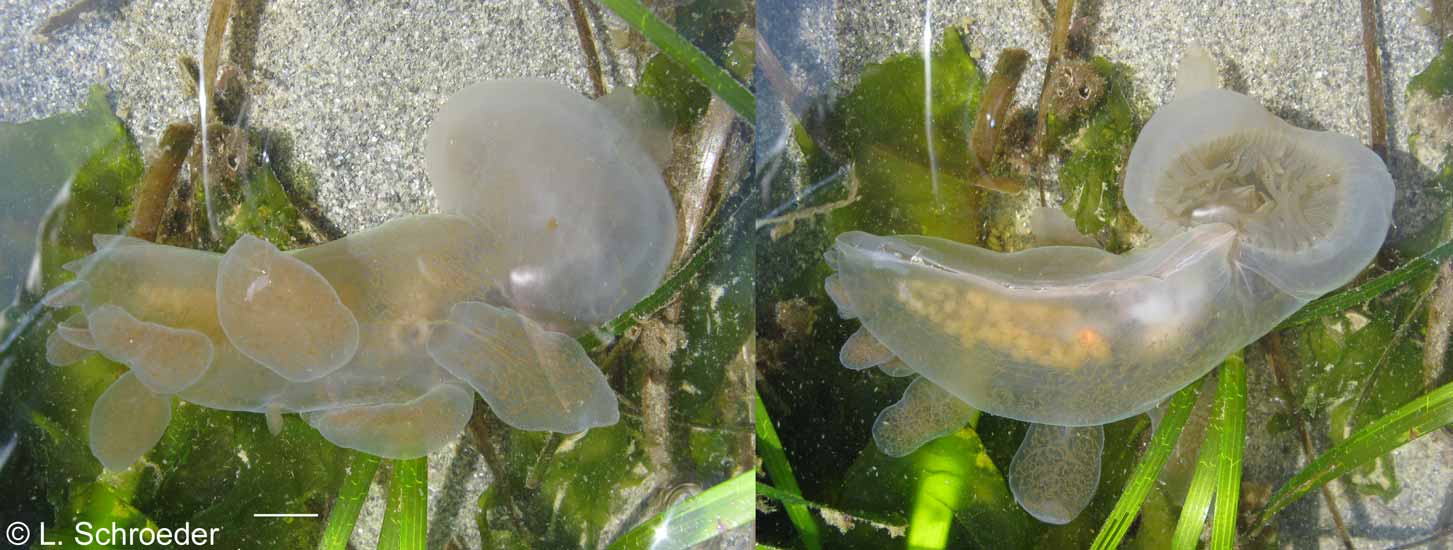 both are Birch Bay State Park, WA, intertidal
both are Birch Bay State Park, WA, intertidal
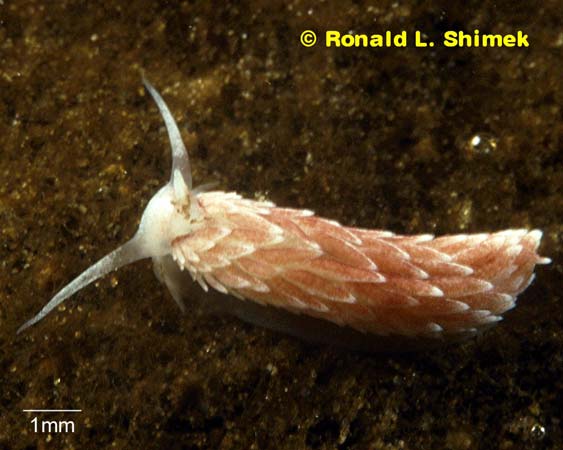 Burien, WA, subtidal
Burien, WA, subtidal
Cerberilla mosslandicaMcDonald and Nybakken, 1975Moss Landing Aeolidsubtidal size to 9mmsouthern California to southern BCThis species burrows in soft sediments.
Dendronotidae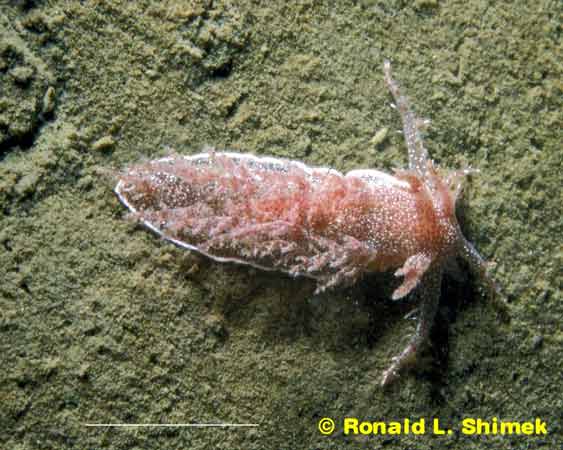
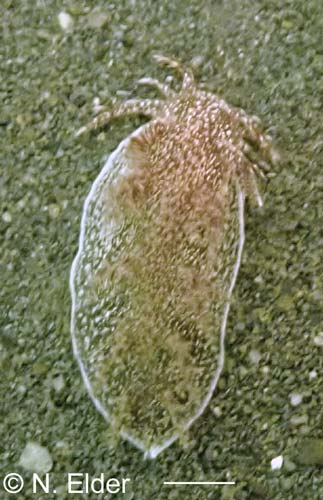
Waldron Island, WA, subtidal Freshwater Bay, WA
subtidal
Arminidae
 Shilshoe Bay, WA, subtidal
Alki Point, WA, subtidal eating sea pens
Shilshoe Bay, WA, subtidal
Alki Point, WA, subtidal eating sea pensArmina californica (Cooper, 1963)
Striped Nudibranch
intertidal
to 230m on sandy bottoms Panama to
northern Alaska size to 7cm
This
species is infrequently found intertidally in the northwest. It
has a distinct look and can't be confused with any other species.
(synonyms - Armina columbiana, Armina vancouverensis, Pleurophyllidia californica)
Dendronotus dalli Bergh, 1879
Dall's Dendronotus
subtidal size to 14cm
northern Washington to northern Alaska
The body is white to pink and the cerata
are tipped in white.
(previous name - Dendronotus elegans)
Dendronotus albopunctatus Robilliard, 1972
White-spotted Dendronotus
subtidal size to 60mm
southern Oregon to northern BC
This species has a wide foot for its body. There are white
spots over a body which is pink to reddish brown.
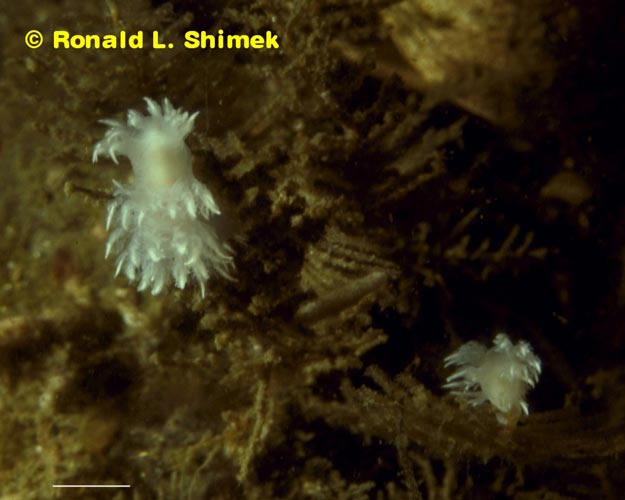 San Juan Islands, WA, subtidal
San Juan Islands, WA, subtidal
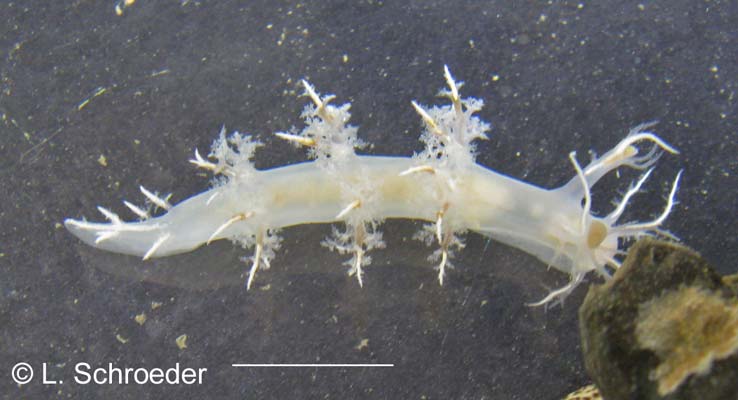
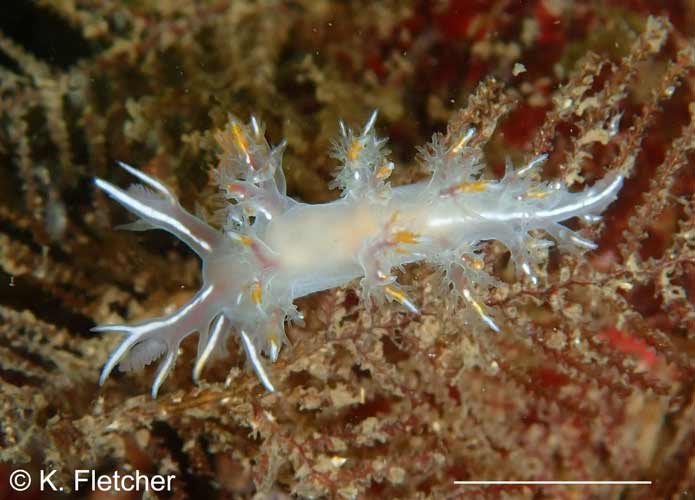
Anacortes, WA, in an
aquarium
Rich Passage, WA,
subtidal
Dendronotus robilliardi Korshunova, Sanamyan, Zimina, Fletcher & Martynov, 2016
Robilliard's Dendronotid
intertidal
to 30m Puget Sound WA to Alaska to
west Russia size to 35mm
Rarely
seen intertidally in our area. Looks similar to D. albus but has a
white line on the back of the rhinophore sheath and the dorsal
appendages are moderately branched. The central appendages may
have orangish bands.
Dendronotus albus MacFarland, 1966
White Dendronotus
intertidal to 30m northern Mexico to central Alaska size to 35mm
This is infrequently seen intertidally. It has a white body and the cerata are tipped with opaque white, orange, red or brown. A white line extends down the back to the tip of the tail. A recent DNA study determined that Dendronotus diversicolor is not a unique species and is now considered to be Dendronotus albus.
This is also evident by the mating pair of the two color forms shown
in our second photo.
 Strawberry Hill, OR, intertidal
Strawberry Hill, OR, intertidal
Hermissenda crassicornis & opalescens
These species co-exist at least as far north as central Oregon. At this location H. crassicornis typically far outnumber the quantity of H. opalescens observed.
Dendronotus rufus O'Donoghue, 1921
Red Dendronotus
subtidal size to 28cm
central Washington to southern Alaska
The projections on the body are all
tipped with red to magenta as well as
edging the foot. The body is white.
Dotidae

Turn Island, WA, subtidal
Rich Passage, WA, subtidal, with eggs
Doto amyra Marcus, 1961 Orange Dotointertidal to subtidal size to 25mm
northern Mexico to southernmost Alaska
Rare to find intertidally, this
species is still under study and may turn out to be more than one
species. The body is translucent white. The bulbous cerata
may be yellow to orange.
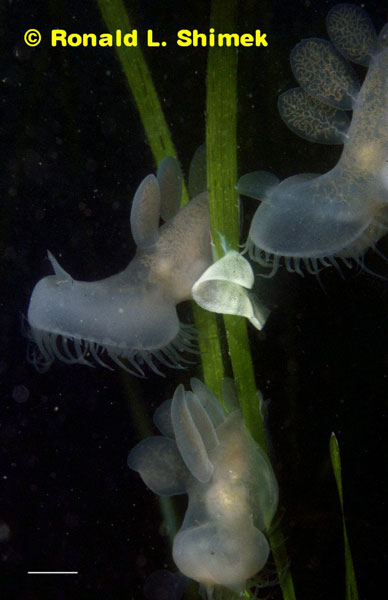
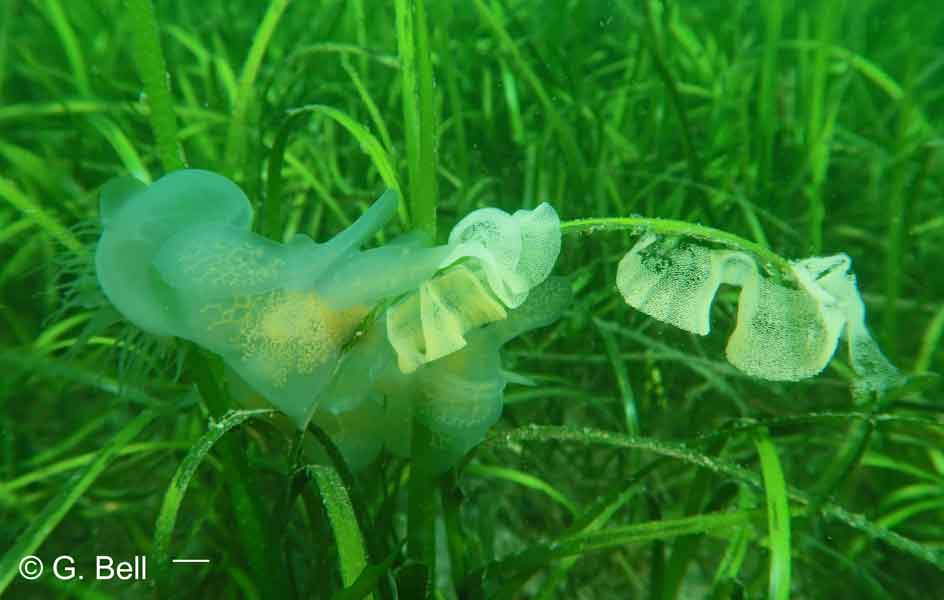
Barkley Sound, BC, subtidal Chemainus, BC, subtidal, with eggs
 Rich Passage, WA, subtidal, with eggsDoto columbiana O'Donoghue, 1921
Rich Passage, WA, subtidal, with eggsDoto columbiana O'Donoghue, 1921
intertidal to 60m size to 12mm
southern California to northern BC
This
species can be difficult to find, hidden among sea fir hydroids.
It is whitish to yellowish gray with varying amounts of brown
patches. The cerata have 4-5 rings of flat tubercles
Melibe leonina (Gould, 1852)
Lion's Melibe
intertidal
to 37m size to 17.5cm
northern Mexico to central
Alaska
This
is infrequently found intertidally, but when it is it can often be in
very large numbers. It takes a sharp eye to spot this semi-transparent species in a tide pool among eelgrass or seaweed.
(previous name - Chioraera leonina)
This page last revised: 7-2-2024
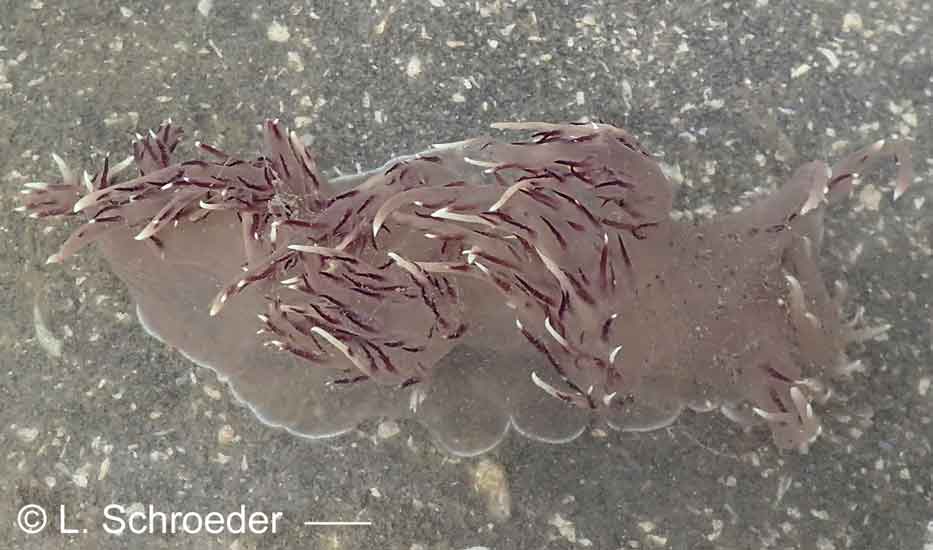
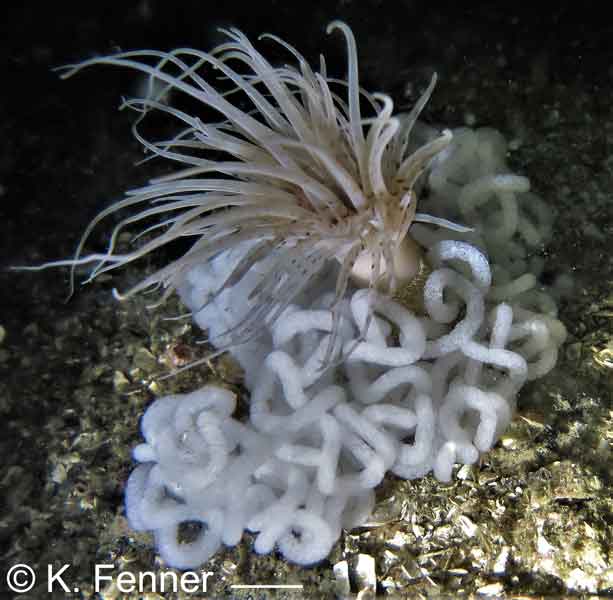 Point Whitehorn Park, WA, intertidal
Maple Bay, BC, subtidal, eggs
Point Whitehorn Park, WA, intertidal
Maple Bay, BC, subtidal, eggs
Dendronotus iris Cooper, 1863
Rainbow Dendronotus
subtidal to 215m size to 30cm
northern Mexico to northern Alaska
This species can exhibit a variety of colors. The gill tufts will be the same color as the body. It has a white line along the rim of the foot.
The last photo shown are the eggs surrounding the tube anemone which is this species' favorite food.
(synonym - Dendronotus giganteus)
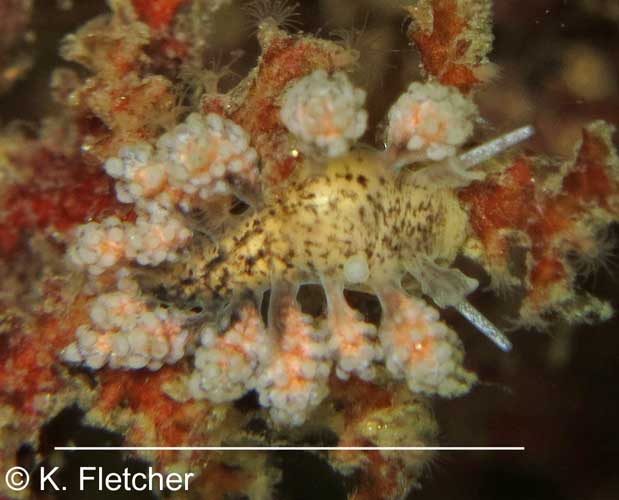
 both Freshwater Bay, subtidalDoto kya Marcus, 1961intertidal to subtidal size to 10mm
both Freshwater Bay, subtidalDoto kya Marcus, 1961intertidal to subtidal size to 10mm
north Mexico to south BC
This species is yellowish white with brown blotches. It looks very much like the D. columbiana except this one lacks the dark rings on its rounded ceratal tubercles. They are very difficult to tell apart
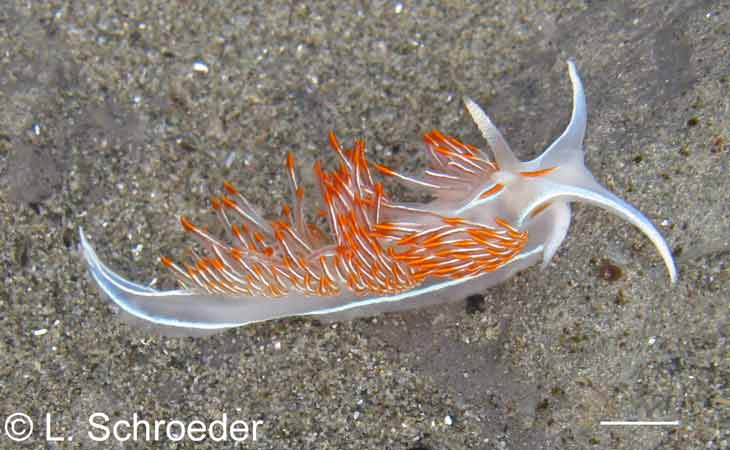 LaPush, WA, intertidal
LaPush, WA, intertidal
Hermissenda crassicornis (Eschscholtz, 1831)
Opalescent Nudibranch *
intertidal to 37m northern California to central Alaska size to 80mm
This
species is often found intertidally. It has a distinctive
bright orange stripe on its head. The center of the cerata may
appear pale orange to dark brown and are usually tipped in white and
orange. There is a white stripe down each cerata which is a
distinguishing feature of this species. In specimens with very
dark cerata, this line can be somewhat obscured.
(previous names - Phidiana crassicornis, Cavolina crassicornis)
 Strawberry Hill, OR, intertidalHermissenda opalescens (J.G. Cooper, 1863)Opalescent Nudibranchintertidal
to at least 20m northern Mexico to
Oregon size to at least 50mmThis species was recently reinstated as a separate species from H. crassicornis.
It also has the bright orange stripe on its head and orange to
brown cerata. But this species does not have the white stripe
along the cerata.(previous name - Aeolis opalescens)
Strawberry Hill, OR, intertidalHermissenda opalescens (J.G. Cooper, 1863)Opalescent Nudibranchintertidal
to at least 20m northern Mexico to
Oregon size to at least 50mmThis species was recently reinstated as a separate species from H. crassicornis.
It also has the bright orange stripe on its head and orange to
brown cerata. But this species does not have the white stripe
along the cerata.(previous name - Aeolis opalescens)
Flabellinopsidae
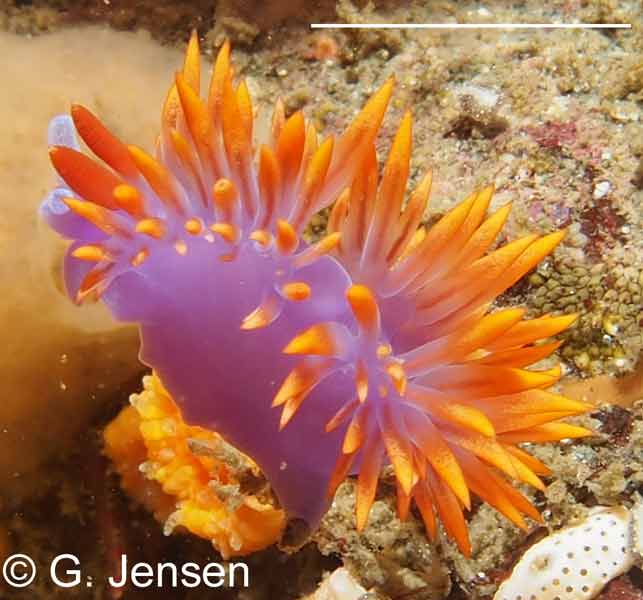
both - Neah Bay, WA, subtidal
Flabellinopsis iodinea (Cooper, 1862)
Spanish Shawl
intertidal to 140m size to 60mm
northern Mexico to Vancouver Is. BC; Ecuador; Galapagos
This colorful species is rarely seen in WA and BC. It seems to arrive only
during extremely warm summers. It is hard to mistake the purple body and bright orange cerata with any other species.
(previous name - Flabellina iodinea, Coryphella iodinea)

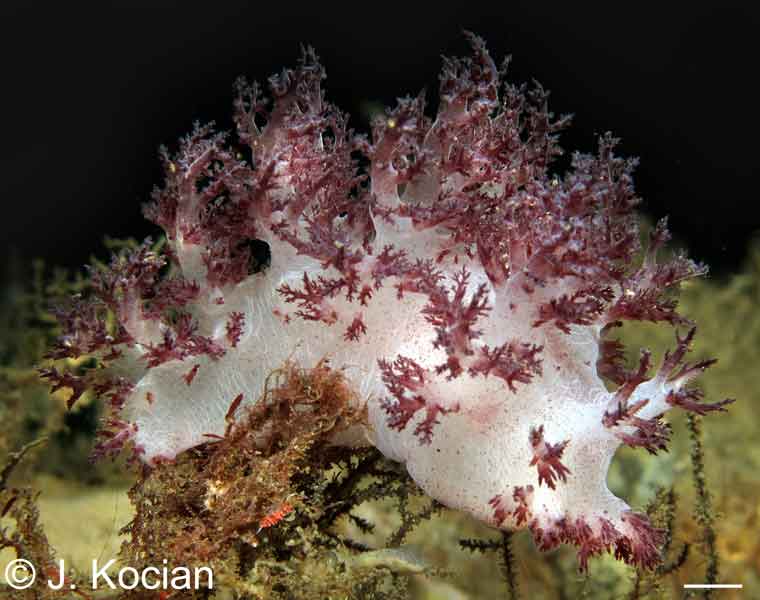
Friday Harbor, WA, subtidal
Whidbey Island, WA, subtidal



